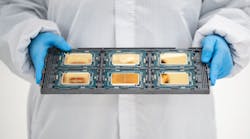Intel and Siemens Scope Out More Sustainable Future for Chips
Intel is teaming up with Siemens in an undertaking to optimize the energy efficiency and sustainability of chips at every stage of their lifecycle, from manufacturing to when they’re embedded in end products.
In recent years, Intel has undergone a revamp of its manufacturing capabilities. It’s investing tens of billions of dollars to expand and upgrade its fabs around the world, in hopes of regaining the title of the world’s most advanced chip supplier as well as building a foundry business that can rival TSMC. But it’s pursuing those expansion plans with a special focus on conserving as much electricity and resources as possible and minimizing its impact in terms of carbon emissions that affect climate change.
The Siemens partnership aims to help Intel operate its chip facilities more efficiently and keep power requirements from getting out of control, according to Keyvan Esfarjani, Intel’s chief global operations officer. “The world needs a more globally balanced, sustainable, and resilient semiconductor supply chain to meet the increasing demand for chips.”
The deal covers several areas of collaboration, including identifying new ways to optimize power use in fabs and reducing carbon emissions across the supply chain using Siemens’ automation hardware, software, and electrical equipment. Siemens signaled the deal would grant it valuable insights into Intel’s operations that it can apply to other power-hungry chipmakers—and even to the broader field of manufacturing.
For instance, the companies will develop “digital twins” of Intel’s complex, capital-intensive factories, where every percentage of efficiency gained is meaningful. And they will explore how these digital replicas can be deployed more broadly.
Chipmaking is Becoming Even More Power-Hungry
Fabricating chips is one of the most complicated and expensive endeavors in the manufacturing realm. Semiconductor makers guzzle huge amounts of electricity to power the state-of-the-art equipment in their fabs. Typically outfitted with 1,000 or more tools per production line, the most advanced facilities run around the clock and can require more than 100 megawatt-hours (MWh) of electricity per hour, estimates McKinsey.
But modern fabs aren’t getting any less power-hungry. As companies continue to expand their operations and upgrade to smaller, more advanced nodes, they’re consuming more power and burning through more resources, contributing to the overall carbon footprint of chipmaking.
One of the largest users of power in a modern fab is the extreme ultraviolet (EUV) lithography machine. These bus-shaped systems heat up a small quantity of tin to the point where it releases intense beams of light with a very short wavelength that then bounce off a complex cascade of mirrors. The light is used to carve transistor-shaped patterns into silicon wafers with nanometer-scale precision, which is vital for fabricating the most advanced logic and memory chips.
Besides their complexity and cost, EUV tools are also uniquely power-hungry. Each system is estimated to run on a full megawatt of electricity—or roughly 10X more than existing generations of lithography gear. For its part, Intel is stepping up production of chips based on the “Intel 4” node. It will be the company’s first technology process to take advantage of EUV tools, which typically cost more than $150 million each.
The other problem is that no alternative exists for EUV. As a result, the technology poses a potential stumbling block to the chip industry’s drive to reach net-zero greenhouse gas emissions. Experts warn that the industry’s carbon emissions could climb to 3% of the global total by 2040.
Supporting the Supply Chain’s Shift to Clean Power
To reduce its negative impact on the environment, Intel procures more than 90% of the electricity used to run its fabs and various other operations around the world from renewable sources. The goal is to fully power itself using renewable sources by 2030. The company also supports its supply chain's shift to renewable electricity.
According to both companies, the deal will help Intel explore ways to minimize energy use through advanced modeling of natural resources and environmental footprints.
But there are limits to what Intel can do at this point to reduce its carbon footprint. Intel can only directly affect Scope 1 and Scope 2 emissions, which are produced directly by its operations and energy use. The challenge is tackling Scope 3 emissions that stem from the thousands of other sources in front and behind it. This includes companies that supply everything from equipment used in its fabs to raw materials used to create chips. These types of emissions even involve products equipped with Intel’s chips.
Thus, Intel intends to work with Siemens to model more of its supply chain and gather data on what happens to its chips once they’re embedded in end products—a move that it hopes will help the chip sector make faster progress on reducing its collective carbon footprint.

